This spicy gochujang shakshuka is made of eggs poached in a delicious gochujang tomato sauce. It’s my take on the classic Middle Eastern dish with the addition of gochujang or Korean red pepper paste. The gochujang imparts a sweet, savory, spicy, and bold taste that’s uniquely delicious!
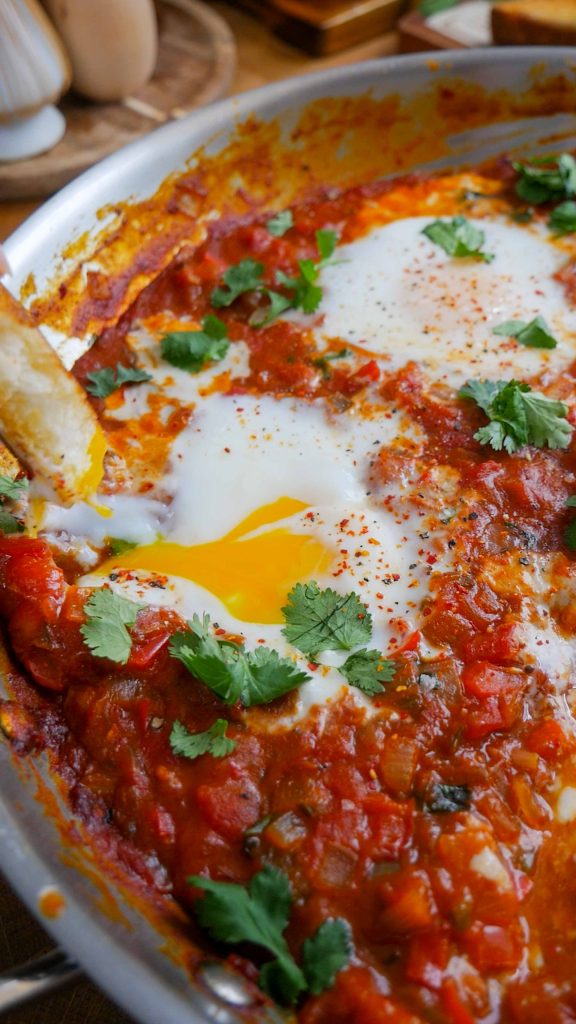
Why you’ll love this recipe
In my opinion, shakshuka is one of those dishes you can enjoy any time of the day — from breakfast to lunch to dinner. All you need is a side of toasted crusty bread and you have a well-balanced and complete meal!
What I find most fascinating about shakshuka is the wide variety of preparation methods based on region, culture, and ingredients. Each family and household has their own version and I think I’ve nailed my family’s version of shakshuka. Now, don’t get me wrong, this is by no means a traditional shakshuka recipe but it does incorporate very similar ingredients like tomatoes, onions, red bell peppers, and spices like paprika and coriander.
One of my recent favorite flavor combinations is tomatoes and gochujang so instead of using tomato paste, which is also a common ingredient in some shakshuka recipes, I opted to use gochujang. Gochujang is a bold condiment and can be quite overpowering but I think it complements the tomato sauce deliciously. It adds a slightly sweet, spicy, and umami undertone that lends to the already rich tomato sauce, making it even deeper.
What’s more, is that this is a one-pot dish that’s incredibly quick and easy to make! All you need is one pan, and you can cook it and eat it straight out of the pan. Talk about easy cleanup!
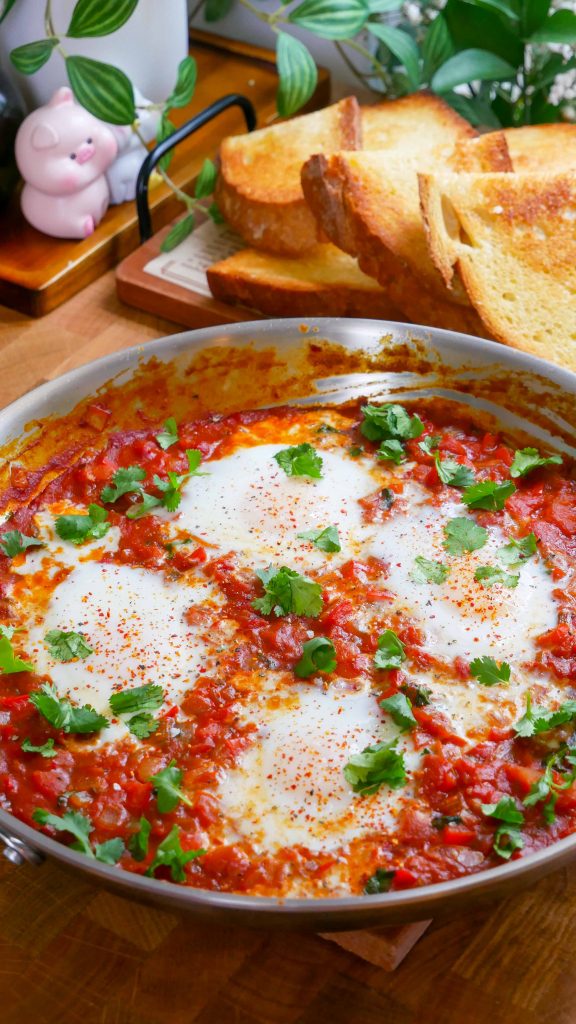
Spicy Gochujang Shakshuka Ingredients & Substitutions
Canned whole tomatoes: I chose to use canned tomatoes because they generally have a consistent flavor and also yield more liquid than fresh tomatoes. Fresh tomatoes vary based on seasonality, variety, and ripeness, so it can affect the end result, especially with a tomato-based dish like this. Now this is not to say you can’t use fresh tomatoes – you definitely can and it’d be even better if they are in season! It’s just my preference to use canned tomatoes.
When using fresh tomatoes, you can either chop them into chunks then saute them with the aromatics. If you want to skin them for better texture, bring a deep pot with water to a boil. Using a knife, mark the tomatoes with an X on the opposite side of the stem. Quickly dip the tomatoes into the boiling water for a minute or until you see the skin releasing, then immediately place them in an ice bath. Peel off the skin by hand. The peeled tomatoes are now ready to use!
Eggs: depending on the side of your pan and the number of people you’re serving, you’ll need 4 to 5 eggs. Be sure to use the freshest and highest quality eggs you can find!
Red bell pepper: Lends a sweet, peppery taste to the sauce. This can be substituted with green or yellow bell pepper.
Onion: Gives a slightly sweet aroma and flavor to the sauce.
Serrano pepper: This pepper is on the spicier side, which is how I enjoy this shakshuka. If you want something milder, you can use jalapenos or skip it completely.
Garlic cloves: Adds a punch of spice and deep flavor to the dish. Feel free to add as much as you desire!
Gochujang: Gochujang or Korean red chili paste is the secret ingredient in this dish. It’s sweet, savory, and subtly spicy. It comes in various spice levels ranging from mild, medium, hot, and very hot. For this recipe, I used medium which is the perfect amount of heat for me. Gochujang can be substituted with tomato paste.
Gochugaru: Also known as Korean red chili powder, it is a slightly sweet and smoky spice that’s more complex in flavor than regular chili powder. This can be substituted with red chili flakes.
Paprika: A common spice added to shakshuka! It adds another layer of spicy and subtly sweet flavors.
Coriander: Adds a nutty, warm, citrusy flavor to the sauce.
Cilantro: Adds a bright, fresh taste with a hint of pepperiness. It also adds a nice pop of color for garnish
Olive oil: For sauteing. Compared with other cooking oils, it has a slightly grassy and peppery taste. You can otherwise use any regular neutral-tasting oil like avocado, sunflower, or vegetable oil.
Garlic Bread Ingredients & Substitutions
Bread: Use any fresh crusty bread such as baguette, sourdough, or Italian loaf bread.
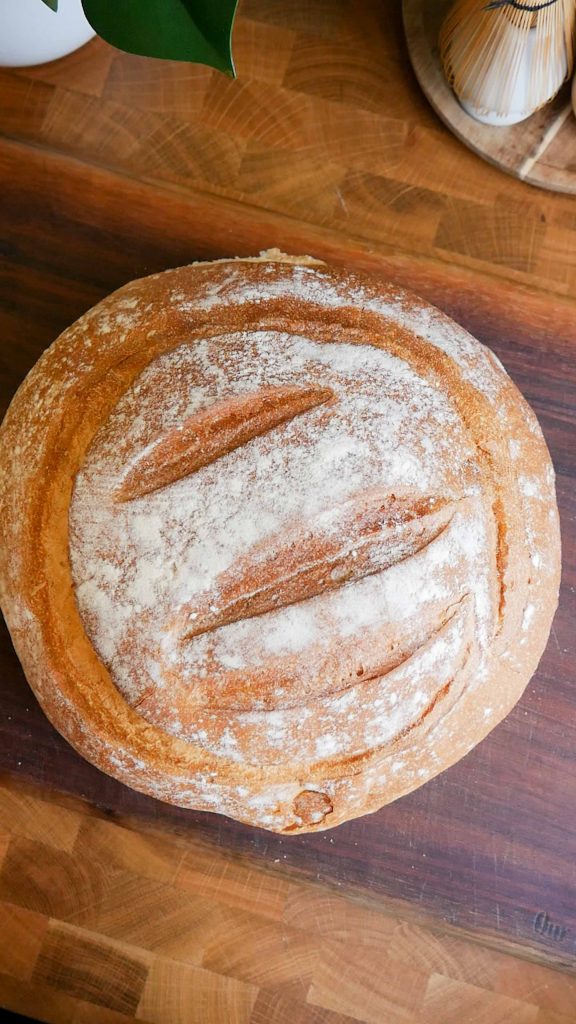
Olive oil: Helps the bread crisp up!
Garlic clove: You will need just a few cloves to rub into the crispy toasted bread.
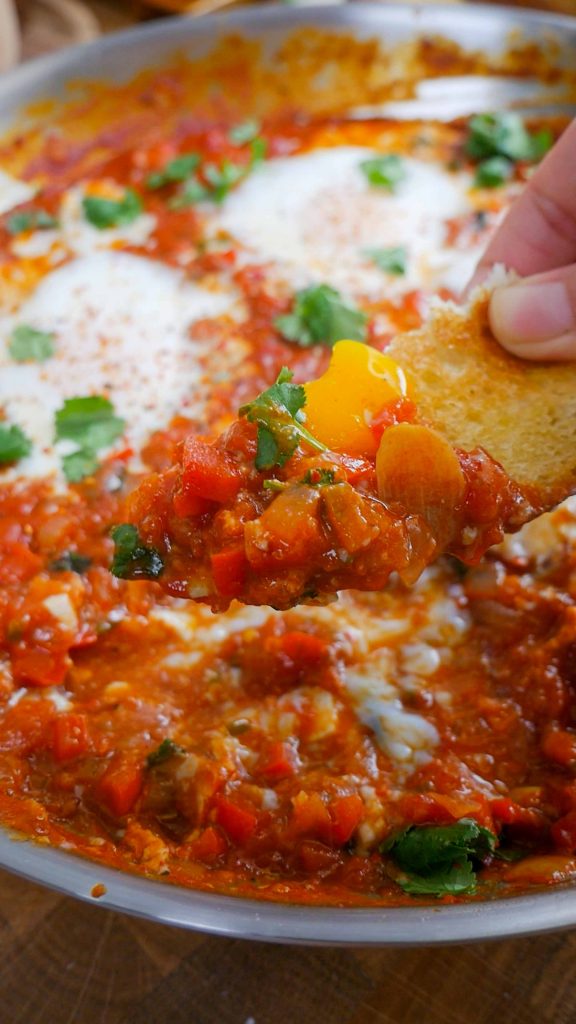
How to Prepare Spicy Gochujang Shakshuka
Step 1: Preheat the oven
Preheat the oven to 350 F or 175C.
Step 2: Saute the veggies
Heat a large oven-proof skillet over medium heat then drizzle in olive oil. Add the bell peppers, onion, pepper, and garlic. Saute for 2 to 3 minutes.
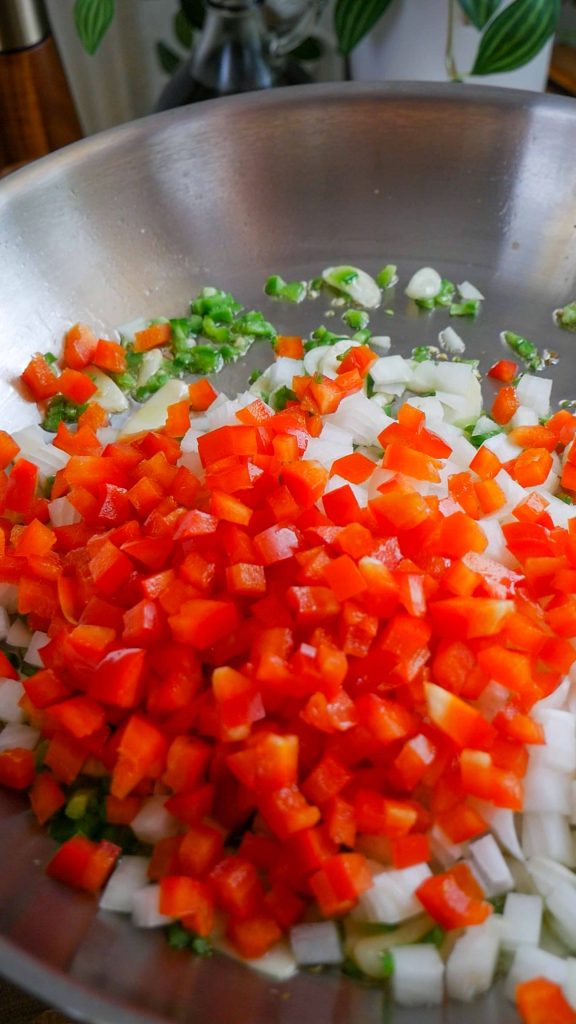
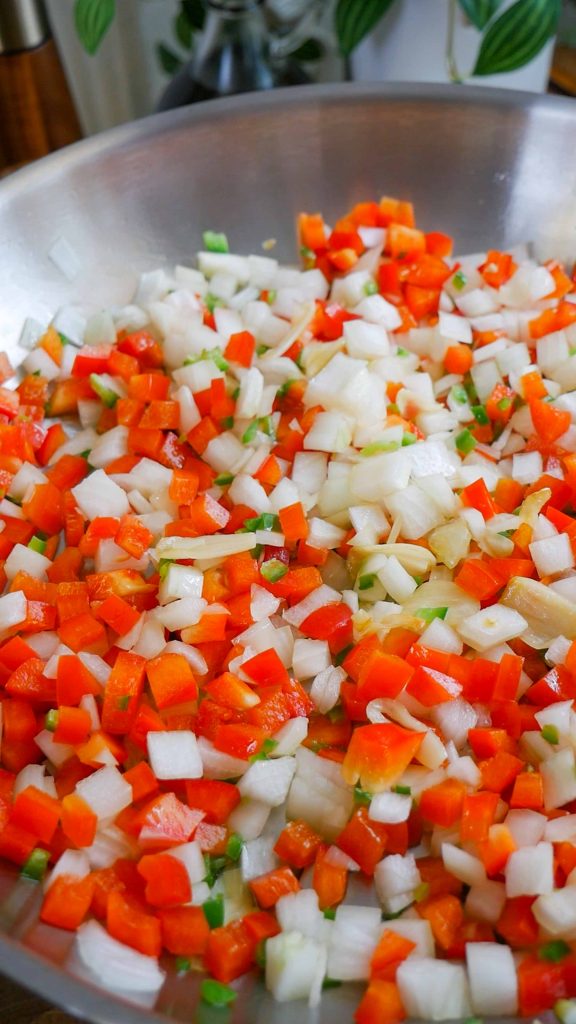
Step 3: Add gochujang
Add gochugaru and gochujang and mix well for about 1 to 2 minutes.
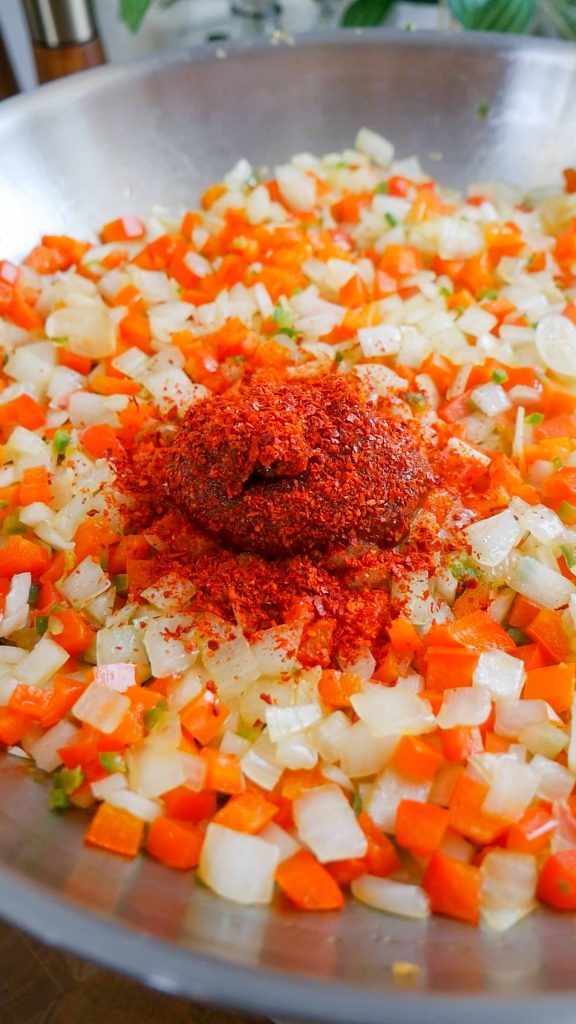

Step 4: Add and smash tomatoes
Add the canned whole tomatoes and smash them into small chunks using a spatula or wooden spoon.
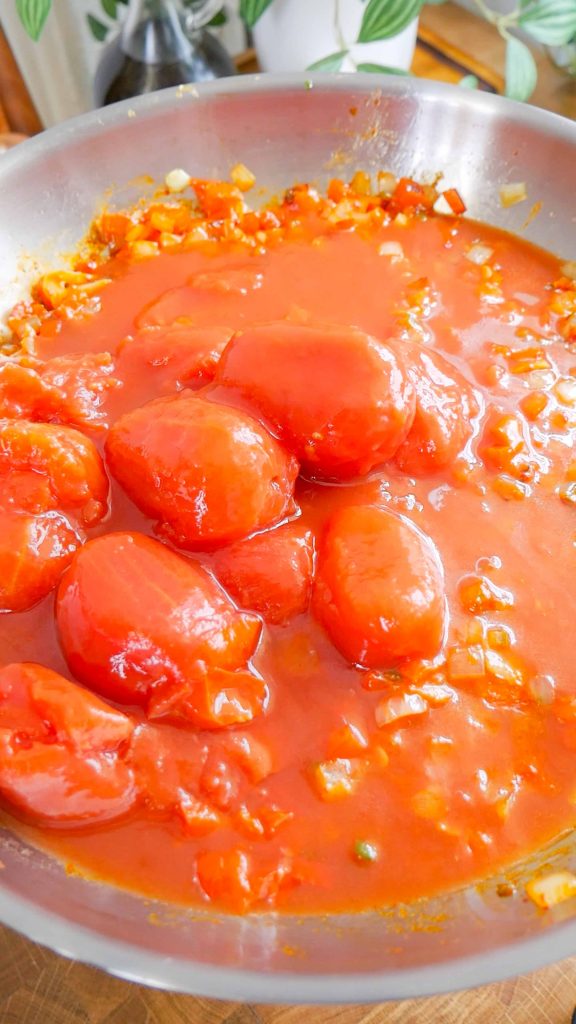
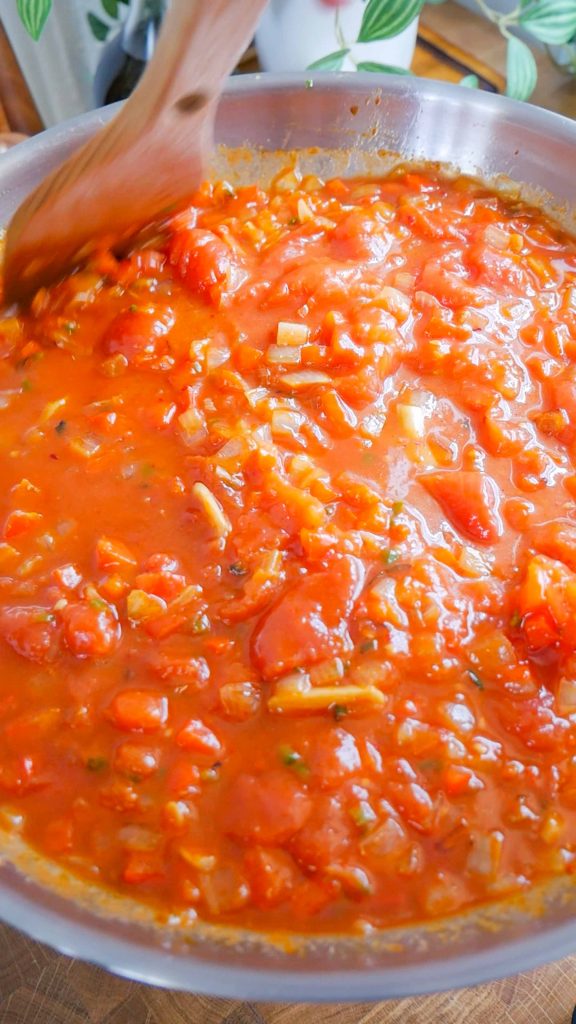
Step 5: Season the sauce
Season with paprika, coriander, salt, and pepper then mix well.
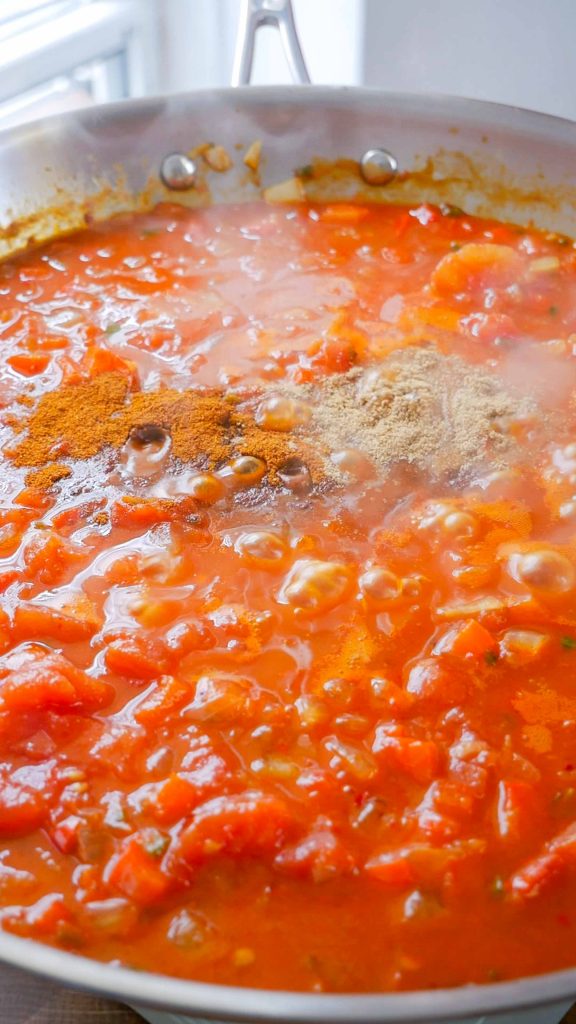
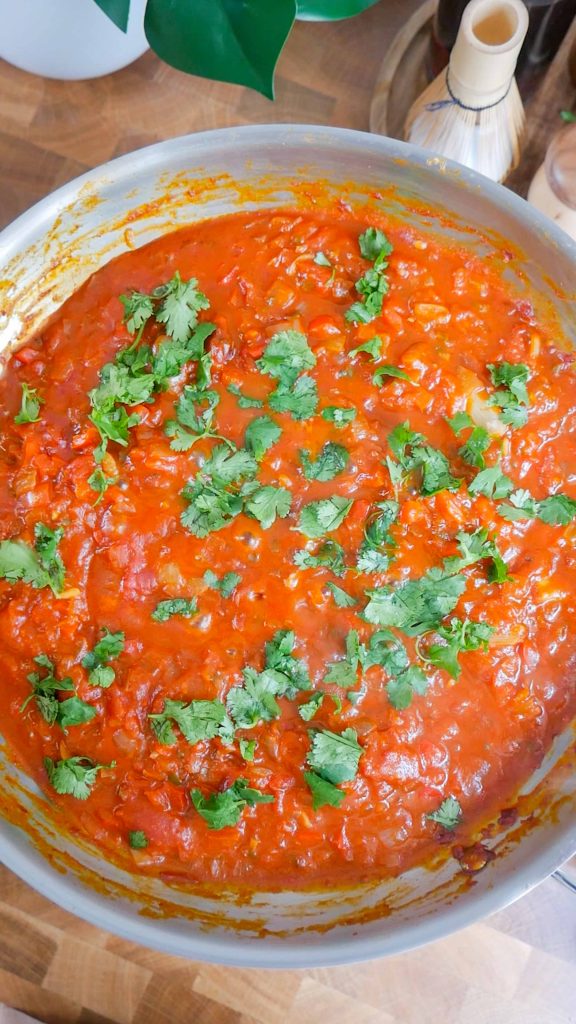
Step 6: Reduce the sauce
Allow the sauce to reduce into a thick pasta sauce consistency, about 3 to 4 minutes.
Step 7: Crack the eggs in
Using a spatula or spoon, make 4 dimples in the sauce. Carefully crack the eggs into each dimple.
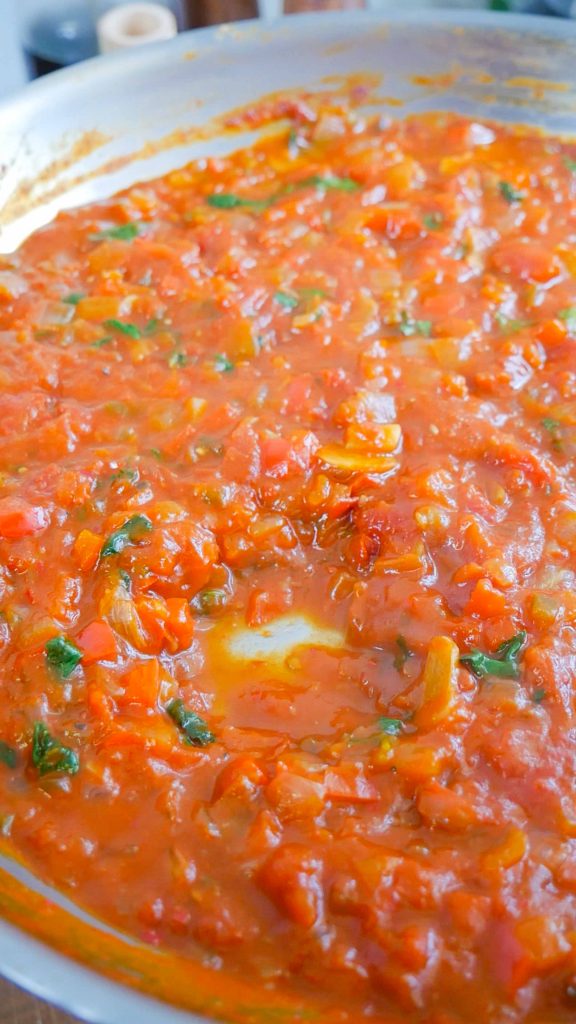



Step 8: Bake
Bake for 8 to 10 minutes, or until the egg whites have set.
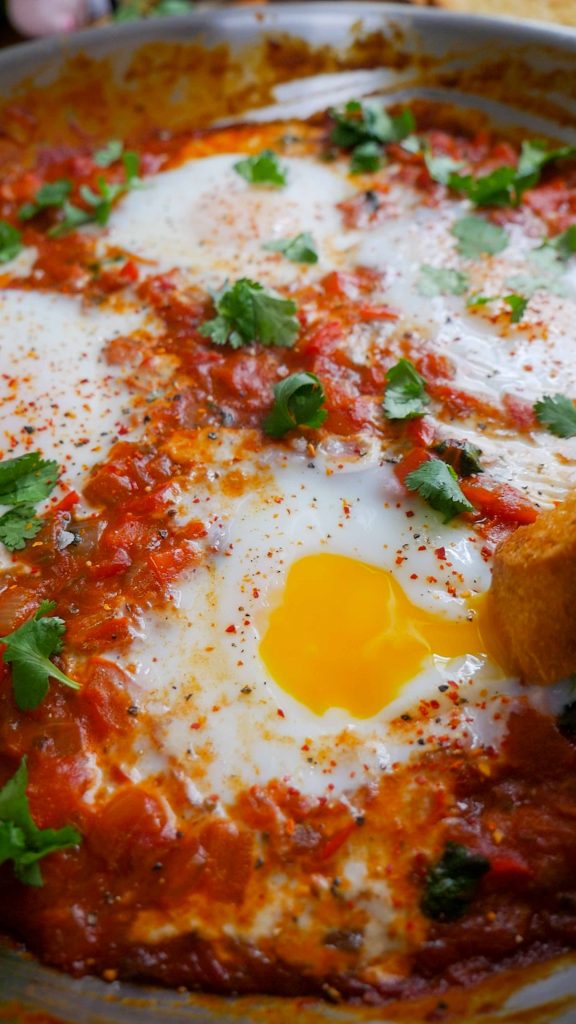
Step 9: Season the eggs
Season the eggs with flakey salt, pepper, and paprika.
Step 10: Garnish and serve
Garnish with cilantro and serve with toasted garlic bread.
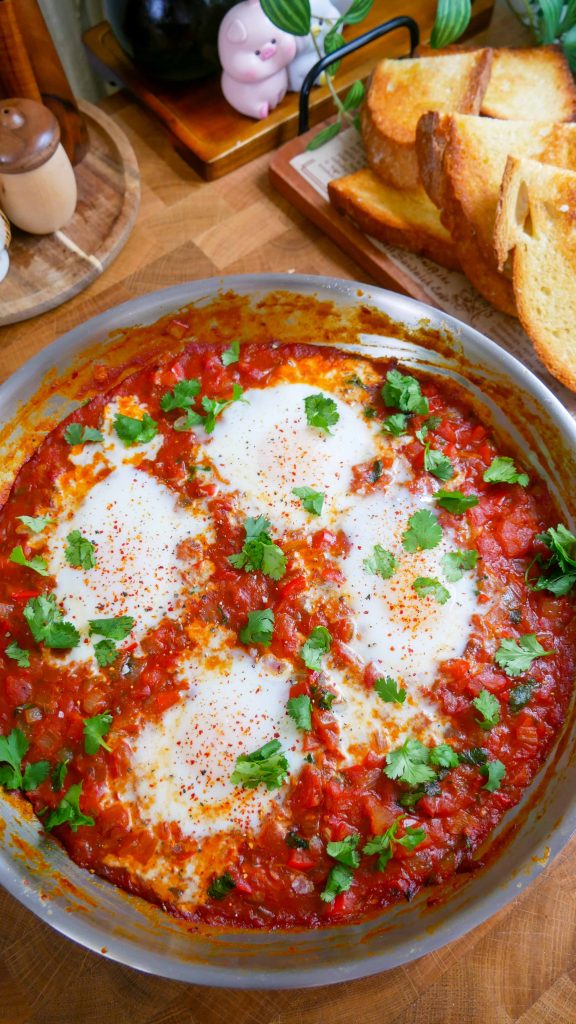
Garlic Bread Instructions
Step 1: Toast the bread
Drizzle olive oil on both sides of each slice of bread. Toast it in a pan over medium-low heat until lightly browned.
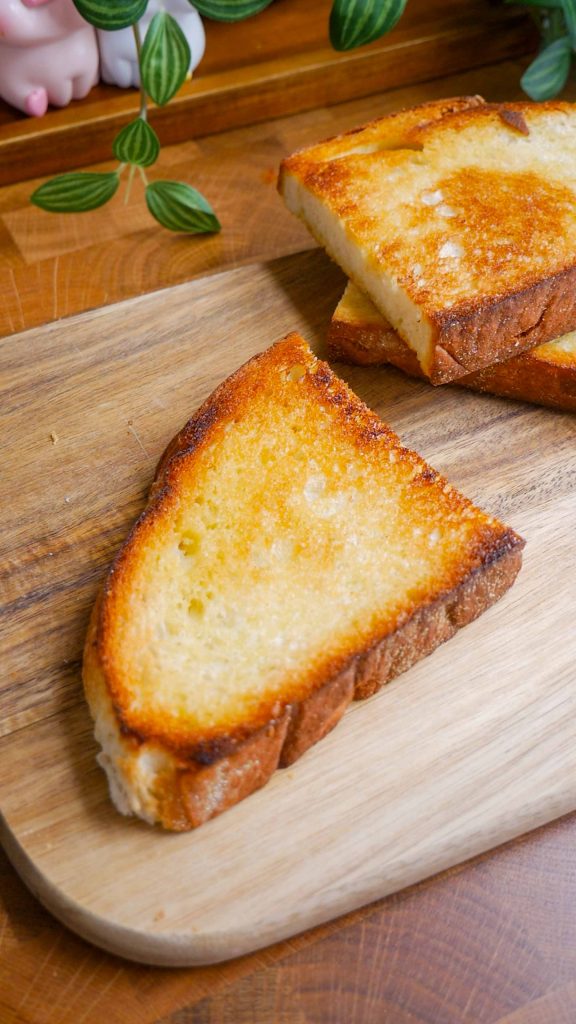
Step 2: Rub with garlic
While the bread is still warm, rub the garlic clove onto both sides of the bread to infuse the garlic flavor.

Preparation Tips for Spicy Gochujang Shakshuka
Here are some helpful tips on making the best spicy gochujang shakshuka at home.
- Use a heavy-bottomed pan such as a stainless steel pan. These types of pans are good to use because they distribute heat evenly, making sure that all the eggs will cook evenly at the same time. Stainless steel pans are also non-reactive, which means cooking highly acidic foods like tomatoes will not cause the food to taste metallic.
- Saute the aromatic vegetables well. This will bring out so much flavor and draw out their natural sweetness. To achieve this, make sure to preheat the pan. Once the vegetables hit the hot pan, you should hear a sizzle. Let them cook, stirring every once in a while to ensure even cooking and prevent burning.
- Do not overcook the eggs, unless you prefer your eggs well-done. For shakshuka, the yolks should be slightly runny.
- Feel free to add other ingredients into the sauce to make it heartier. For instance, you can add a bunch of spinach or carrots for added fiber. You can also add ground beef or pork for additional protein. Just make sure to adjust and taste the seasoning as you go.

Frequently Asked Questions
What is gochujang sauce made of?
Gochujang is made of Korean pepper flakes, glutinous rice, fermented soybean powder, and salt. The ingredients are mixed and fermented, which is where the magic happens. The flavors develop into a deep, complex concoction that is spicy, sweet, savory, and umami, all at the same time.
Is gochujang paste really spicy?
Generally, the gochujang used in restaurants is not very spicy. It leans more on the sweet and savory side, however, gochujang does come in various spice levels. They’re usually sold as mild, medium, hot, and very hot, and depending on which one you use, will ultimately affect the spiciness of the dish.
Can I use gochujang sauce instead of paste?
Gochujang sauce or cho jang is gochujang paste mixed with other additional ingredients like vinegar, sugar, and sesame oil to achieve a thinner consistency that’s usually used for dipping or as a condiment in bibimbap. It tastes very similar and you can use gochujang sauce instead of gochujang paste but it will taste slightly different.
What is gochugaru?
Gochugaru, also known as Korean red pepper powder, are Korean peppers that are either roasted or sun-dried first before ground into a powder. This process makes its flavor more complex than regular chili powder. Gochugaru is slightly sweet and smokey, while chili powder is usually just spicy.
What is the difference between shakshuka and gochujang shakshuka?
The traditional shakshuka is said to have originated in North Africa. Through the migration of North Africans to Israel and other nearby countries, shakshuka became popular and has become one of their staple dishes to date. Depending on the region and culture, shakshuka is prepared in different ways. However, it’s generally made of eggs poached in seasoned tomato sauce, most commonly served with bread for dipping.
This gochujang shakshuka is very similar but with a little extra dazzle with the addition of gochujang! It’s a bit sweet, spicy, savory, and umami, and deepens the flavor. If you’re a fan of shakshuka, this unique take is a must-try!
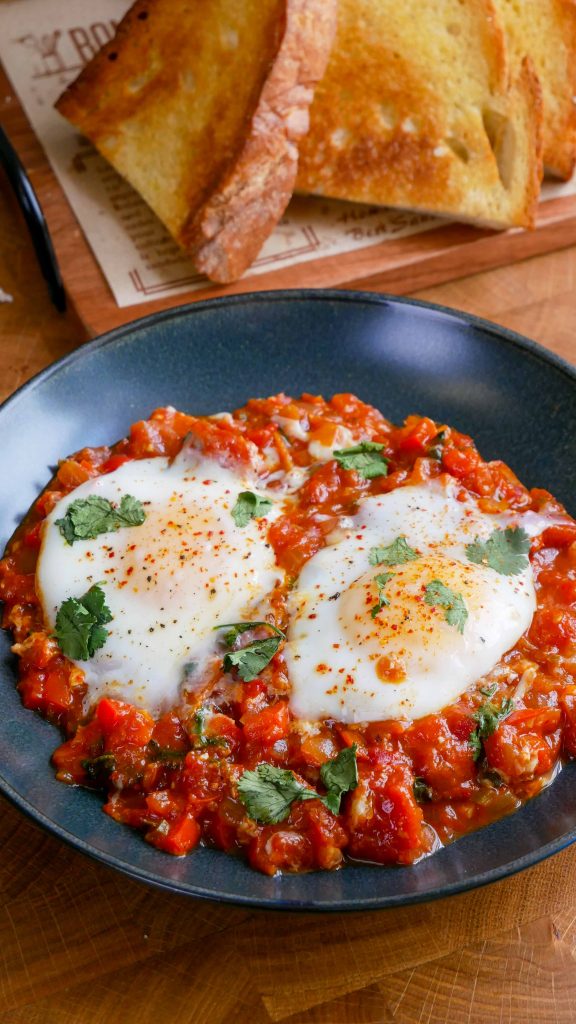
Looking for more easy and delicious egg recipes?
Fancy Korean Egg Drop Sandwich — Enjoy your eggs for breakfast with this fancy version of the viral Korean egg drop breakfast sandwich. It’s made of scrambled eggs, crispy bacon, and cheese on toasted milk bread, drizzled with a delectable spicy sweet mayo. What makes it fancy is ikura or salmon roe which gives it a fresh, briny taste.
Curry Udon Noodles with Egg — If you’re looking for a no-frills, quick, and easy weeknight meal, this curry udon with egg is the one for you! There’s something so incredibly comforting about a bowl of udon noodles that are smothered in a rich and velvety curry. And best of all – it only takes 20 minutes to prepare!
Chinese Scrambled Eggs with Shrimp — This Cantonese-style scrambled eggs and shrimp recipe combines silky eggs with juicy succulent shrimp. Once you take a bite, you’ll understand why it’s a Cantonese staple. 10 minutes is all you need to prepare this delicious dish for dinner!
Chinese Tea Eggs — This is a Chinese street food snack I grew up eating. Soft-boiled jammy eggs are marinated overnight in black tea leaves, soy sauce, and other seasoning ingredients and spices. The result is a super flavorful batch of eggs that are tasty as snacks and also good with rice.
Korean Steamed Eggs — Also called “gyeran jjim” in Korean, is a classic side dish that is usually served in Korean BBQ restaurants. I added a bit of fermented shrimp (saeu-jeot) which adds tons of umami flavor to the eggs. Easily recreate this Korean classic egg dish at home in 15 minutes using only a few ingredients.
Japanese Egg Sandwich — Also called “tamago sando” in Japanese, these convenience store sandwiches are packed with rich and creamy egg filling. A good source of protein that will keep you energized throughout the day.
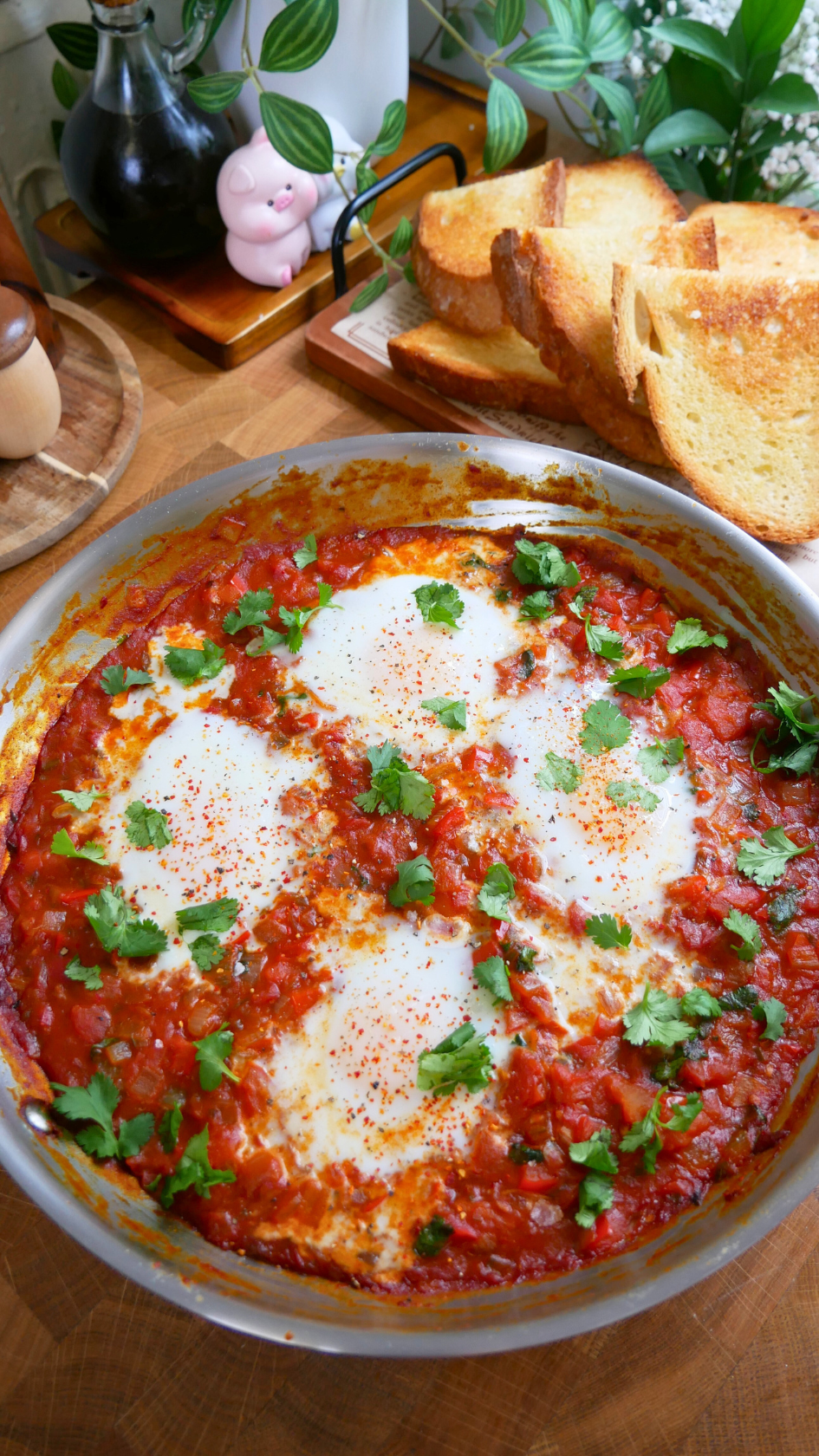
Spicy Gochujang Shakshuka Recipe
Ingredients
- 1 15 oz canned whole tomatoes
- 4 eggs
- 1 red bell pepper deseeded and diced
- 1 medium onion diced
- 1 serrano pepper diced
- 3 garlic cloves thinly sliced
- 2 tbsp gochujang (Korean red chili paste) to taste
- 1 tsp gochugaru (Korean red chili flakes) substitute with red chili flakes
- 1 tsp paprika
- 1 tsp coriander
- 2 tbsp cilantro roughly chopped
- 2 tbsp olive oil
Garlic Bread
- 4-5 slices bread
- 2 tbsp olive oil
- 1 garlic clove
Instructions
- Preheat oven to 350F or 175C.
- Heat a large oven-proof skillet over medium heat then drizzle in olive oil.
- Add the bell peppers, onion, pepper, and garlic. Saute for 2 to 3 minutes.
- Add gochugaru and gochujang and mix well for about 1 to 2 minutes.
- Add the canned whole tomatoes and smash them into small chunks using a spatula or wooden spoon.
- Season with paprika, coriander, salt and pepper then mix well.
- Allow the sauce to reduce into a thick pasta sauce consistency, about 3 to 4 minutes.
- Using a spatula or spoon, make 4 dimples in the sauce. Carefully crack the eggs into each dimple.
- Bake for 8 to 10 minutes, or until the egg whites have set.
- Season the eggs with flakey salt, pepper, and paprika.
- Garnish with cilantro and serve with toasted garlic bread.
Garlic Bread Instructions
- Drizzle olive oil on both sides of each slice of bread. Toast it in a pan over medium-low heat until lightly browned.
- While the bread is still warm, rub the garlic clove onto both sides of the bread to infuse the garlic flavor.